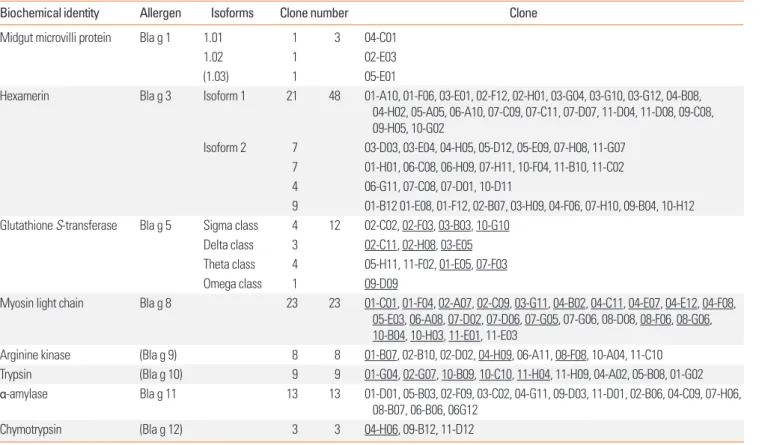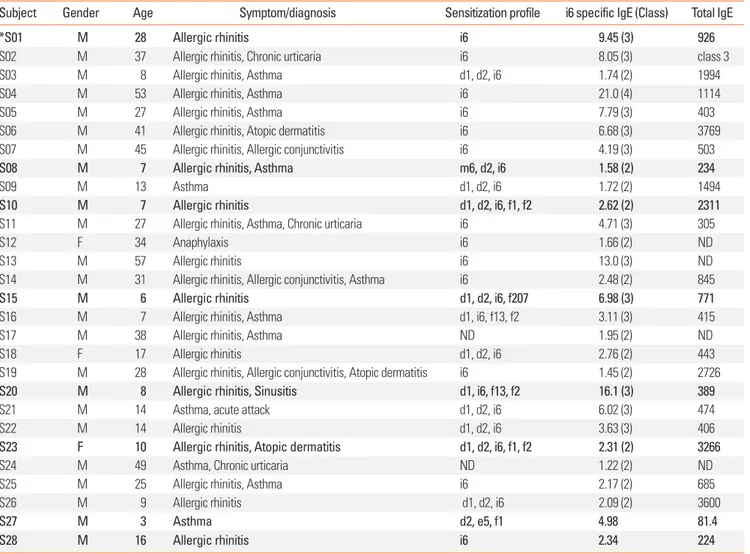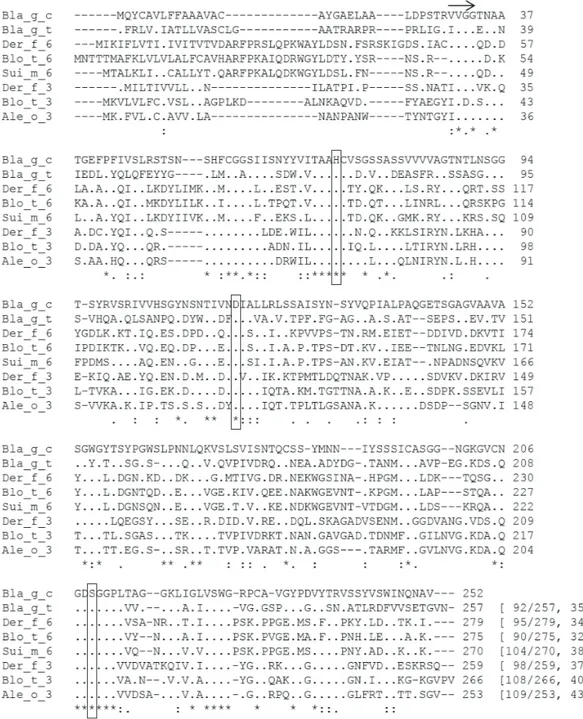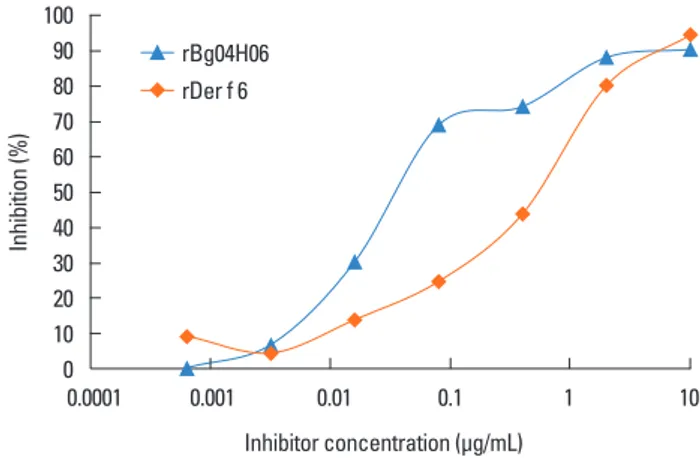INTRODUCTION
Proteases in allergen extracts are thought to be important fac-tors in primary sensitization, not only to the protease itself but also to bystander allergens. They also may exacerbate allergic disorders by damaging epithelial barrier function.1 Abolishment of the proinflammatory effects of German cockroach extract by serine protease inhibitors suggests the important role of prote-ases in inflammation of airway epithelial cells.2
However, none of the German cockroach allergens listed in International Union of Immunological Society (IUIS) allergen nomenclature have been shown to have serine protease activi-ty. Recently, we found that the IgE binding proteins detected by proteomics from German cockroach fecal extract were mainly digestive enzymes such as amylase, midgut carboxy peptidase A, astacin-like metalloprotease, trypsin, and chymotrypsin.3
Chymotrypsin-like protease was first described as an allergen from Aspergillus fumigatus.4 Chymotrypsin-like serine proteas-es were also identified as allergens from house dust mitproteas-es5-7; however, only a small amount of mite chymotrypsin was found in the extract, suggesting a limited role in mite allergenicity.8 Molecular cloning of mite chymotrypsin was performed for
Dermatophagoides pteronyssinus (Der p 6) in 19969 and for D.
farinae (Der f 6).10 α-chymotrypsin activity was not detected
from German cockroach extract by ApiZym assay (bioMerieux, Marcy l’Etoile, France), although various protease activities were detected.11 Much stronger gelatinolytic activity was also detected from cockroach extracts compared to house dust mite extracts, as measured by zymography.
In this study, we identified a chymotrypsin-like clone by ex-pressed sequence tag (EST) analysis and produced its recombi-nant protein and evaluated its allergenicity using ELISA. MATERIALS AND METHODS
Expressed sequence tag analysis
A cDNA library for the German cockroach was constructed us-ing a Lambda ZAP II XR library construction kit (Stratagene, La Jolla, CA, USA). The phage library was converted to a phagemid library by mass excision and was transformed into Escherichia
coli. The transformed colonies were randomly selected and
pre-Allergenic Characterization of a Novel Allergen, Homologous to
Chymotrypsin, from German Cockroach
Kyoung Yong Jeong, Mina Son, Jae-Hyun Lee, Chein-Soo Hong, Jung-Won Park*
Department of Internal Medicine, Institute of Allergy, Yonsei University College of Medicine, Seoul, KoreaThis is an Open Access article distributed under the terms of the Creative Commons Attribution Non-Commercial License (http://creativecommons.org/licenses/by-nc/3.0/) which permits unrestricted non-commercial use, distribution, and reproduction in any medium, provided the original work is properly cited.
Purpose: Cockroach feces are known to be rich in IgE-reactive components. Various protease allergens were identified by proteomic analysis of German cockroach fecal extract in a previous study. In this study, we characterized a novel allergen, a chymotrypsin-like serine protease. Methods:
A cDNA sequence homologous to chymotrypsin was obtained by analysis of German cockroach expressed sequence tag (EST) clones. The recombi-nant chymotrypsins from the German cockroach and house dust mite (Der f 6) were expressed in Escherichia coli using the pEXP5NT/TOPO vector system, and their allergenicity was investigated by ELISA. Results: The deduced amino acid sequence of German cockroach chymotrypsin showed 32.7 to 43.1% identity with mite group 3 (trypsin) and group 6 (chymotrypsin) allergens. Sera from 8 of 28 German cockroach allergy subjects (28.6%) showed IgE binding to the recombinant protein. IgE binding to the recombinant cockroach chymotrypsin was inhibited by house dust mite chymo-trypsin Der f 6, while it minimally inhibited the German cockroach whole body extract. Conclusions: A novel allergen homologous to chymotrypsin was identified from the German cockroach and was cross-reactive with Der f 6.
Key Words: Allergens; chymotrypsin; German cockroach
Correspondence to: Jung-Won Park, MD, PhD, Department of Internal Medicine, Institute of Allergy, Yonsei University College of Medicine, 50-1 Yonsei-ro, Seodaemun-gu, Seoul 120-752, Korea.
Tel: +82-2-2228-1961; Fax: +82-2-362-8647; E-mail: parkjw@yuhs.ac Received: July 11, 2014; Accepted: September 30, 2014
•There are no financial or other issues that might lead to conflict of interest.
Allergy Asthma Immunol Res. 2015 May;7(3):283-289.
http://dx.doi.org/10.4168/aair.2015.7.3.283
pared as plasmid DNA. Subsequently, the DNA sequences of the inserts were determined at Macrogen (Daegeon, Korea). All sequences were analyzed with the non-redundant database at the National Center for Biotechnology Information using the Ba-sic Local Alignment Search Tool X (BLASTX). Clones showing homology with known allergens were summarized in Table 1.
Expression of recombinant proteins
For the expression of recombinant proteins, the coding region, which includes an 11-amino acid prosequence and the mature protein, was amplified using the phagemid (BgEST04H06) as a template with oligonucleotide primers (forward: 5’-GCTGAAC-TTGCTGCCCTAGAC-3’, reverse: 5’-TTAAACGGCATTTTGGTT-GAT-3’). Simultaneously, recombinant Der f 6, a chymotrypsin from D. farinae, was also amplified by reverse-transcriptase PCR with oligonucleotide primers (forward: 5’-GATGCACGA-TTTCCACGC-3’, reverse: 5’-TCAAACAATGTTTTTTGT-3’). PCR products were cloned into the pEXP-5NT vector/TOPO vector (Invitrogen Life Technologies, Carlsbad, CA, USA). The orienta-tion of the inserts was confirmed by PCR using T7 primer an-nealing to the vector and reverse primer anan-nealing to the insert. The resultant sequences should contain an additional 22 amino acids (MSGSHHHHHHGSSGENLYFQSL) at the N-terminus. DNA sequences were determined at Solgent (Daejeon, Korea)
and then were transformed into E. coli BL21 (DE3).
Expression of the recombinant proteins was induced by add-ing 1 mM of isopropyl-1-thio-β-galactopyranoside when bacte-ria were grown to an absorbance of 0.6 at 600 nm. Recombinant proteins were purified under denaturing conditions (6 M urea) using Ni-nitrilotriacetic acid-agarose (Qiagen, Valencia, CA, USA) according to the manufacturer’s instructions. Proteins were dialyzed against refolding buffer (0.1 M Tris, pH 8.0, 0.4 M L-Arginine, 0.5 mM oxidized glutathione, 5 mM reduced gluta-thione) and their concentration was determined by Bradford assay (Bio-Rad, Hercules, CA, USA). Proteins were analyzed by 12% polyacrylamide gel containing sodium dodecyl sulfate un-der reducing conditions.
Serum samples
Serum samples were collected from patients at the Allergy-Asthma Clinic at Severance Hospital, Seoul, Korea. Patient con-sent was obtained before blood collection. Sera from allergic pa-tients (25 males and 3 females, mean age 23 years, ranging from 3 to 57 years) with ImmunoCAP (Phadia, Uppsala, Sweden) higher than 0.7 kU/L to the German cockroach were chosen (Table 2). Diagnosis of German cockroach allergy was based on case history and skin test. Seventeen control sera from individu-als with no history of allergic symptoms and negative for
Ger-Table 1. Allergen homologues obtained from German cockroach EST analysis
Biochemical identity Allergen Isoforms Clone number Clone
Midgut microvilli protein Bla g 1 1.01 1 3 04-C01
1.02 1 02-E03
(1.03) 1 05-E01
Hexamerin Bla g 3 Isoform 1 21 48 01-A10, 01-F06, 03-E01, 02-F12, 02-H01, 03-G04, 03-G10, 03-G12, 04-B08, 04-H02, 05-A05, 06-A10, 07-C09, 07-C11, 07-D07, 11-D04, 11-D08, 09-C08, 09-H05, 10-G02
Isoform 2 7 03-D03, 03-E04, 04-H05, 05-D12, 05-E09, 07-H08, 11-G07 7 01-H01, 06-C08, 06-H09, 07-H11, 10-F04, 11-B10, 11-C02 4 06-G11, 07-C08, 07-D01, 10-D11
9 01-B12 01-E08, 01-F12, 02-B07, 03-H09, 04-F06, 07-H10, 09-B04, 10-H12 Glutathione S-transferase Bla g 5 Sigma class 4 12 02-C02, 02-F03, 03-B03, 10-G10
Delta class 3 02-C11, 02-H08, 03-E05
Theta class 4 05-H11, 11-F02, 01-E05, 07-F03
Omega class 1 09-D09
Myosin light chain Bla g 8 23 23 01-C01, 01-F04, 02-A07, 02-C09, 03-G11, 04-B02, 04-C11, 04-E07, 04-E12, 04-F08, 05-E03, 06-A08, 07-D02, 07-D06, 07-G05, 07-G06, 08-D08, 08-F06, 08-G06, 10-B04, 10-H03, 11-E01, 11-E03
Arginine kinase (Bla g 9) 8 8 01-B07, 02-B10, 02-D02, 04-H09, 06-A11, 08-F08, 10-A04, 11-C10
Trypsin (Bla g 10) 9 9 01-G04, 02-G07, 10-B09, 10-C10, 11-H04, 11-H09, 04-A02, 05-B08, 01-G02
α-amylase Bla g 11 13 13 01-D01, 05-B03, 02-F09, 03-C02, 04-G11, 09-D03, 11-D01, 02-B06, 04-C09, 07-H06, 08-B07, 06-B06, 06G12
Chymotrypsin (Bla g 12) 3 3 04-H06, 09-B12, 11-D12
*The deduced amino acid sequences from 1,177 clones were analyzed. A total of 64 clones were shown to be β-actin. Clones with full-length sequence were under-lined. Brackets indicate allergens which are not officially listed in IUIS.
man cockroach allergy on ImmunoCAP assay were included. This study was approved by the institutional review board (4-2009-0717).
Enzyme-linked immunosorbent assay
Serum IgE specific to recombinant allergen was detected by ELISA. Purified proteins (2 μg/mL) were coated in 0.05 M car-bonated buffer (pH 9.6) overnight at 4°C. After blocking with 3% skim milk in phosphate-buffered saline containing 0.05% Tween 20 (PBST), serum samples (1:4 diluted in PBST containing 1% bovine serum albumin) were incubated for one hour. IgE bodies were probed by incubating with biotinylated goat anti-human IgE (1:1,000) (Vector, Burlingame, CA, USA) for an hour, followed by incubation with streptavidin-peroxidase conjugate (1:1,000) (Sigma-Aldrich, St. Louis, MO, USA) for 30 minutes. Color was developed using 3,3’,5,5’-tetramethyl-benzidine (TMB, Kirkegaard & Perry Laboratories, Gaithersburg, MD, USA) as a substrate. After stopping the enzyme reaction with 0.5
M H2SO4, the absorbance at 450 nm was measured. The cutoff value was determined by mean absorbance plus 2 SDs for the negative controls.
For inhibition analysis, 10 μg/mL of recombinant chymotryp-sin from the German cockroach (rBg04H06) was coated onto microtiter ELISA plates. Serum samples (diluted 1:4) from three subjects with positive reactions to rBg04H06 were incubated with 5 serially diluted antigens (rBg04H06 and rDer f 6) starting with an inhibitor concentration of 10 μg/mL. The inhibitor mix-tures were incubated at room temperature for 2 hours and over-night at 4°C. IgE antibodies were detected as described above. RESULTS
Analysis of allergen homologous molecules from the EST database
DNA sequences of 1,226 clones were determined. A total of 1,177 clones showing valid, readable amino acid sequences
Table 2. Clinical features of the enrolled subjects
Subject Gender Age Symptom/diagnosis Sensitization profile i6 specific IgE (Class) Total IgE
*S01 M 28 Allergic rhinitis i6 9.45 (3) 926
S02 M 37 Allergic rhinitis, Chronic urticaria i6 8.05 (3) class 3
S03 M 8 Allergic rhinitis, Asthma d1, d2, i6 1.74 (2) 1994
S04 M 53 Allergic rhinitis, Asthma i6 21.0 (4) 1114
S05 M 27 Allergic rhinitis, Asthma i6 7.79 (3) 403
S06 M 41 Allergic rhinitis, Atopic dermatitis i6 6.68 (3) 3769
S07 M 45 Allergic rhinitis, Allergic conjunctivitis i6 4.19 (3) 503
S08 M 7 Allergic rhinitis, Asthma m6, d2, i6 1.58 (2) 234
S09 M 13 Asthma d1, d2, i6 1.72 (2) 1494
S10 M 7 Allergic rhinitis d1, d2, i6, f1, f2 2.62 (2) 2311
S11 M 27 Allergic rhinitis, Asthma, Chronic urticaria i6 4.71 (3) 305
S12 F 34 Anaphylaxis i6 1.66 (2) ND
S13 M 57 Allergic rhinitis i6 13.0 (3) ND
S14 M 31 Allergic rhinitis, Allergic conjunctivitis, Asthma i6 2.48 (2) 845
S15 M 6 Allergic rhinitis d1, d2, i6, f207 6.98 (3) 771
S16 M 7 Allergic rhinitis, Asthma d1, i6, f13, f2 3.11 (3) 415
S17 M 38 Allergic rhinitis, Asthma ND 1.95 (2) ND
S18 F 17 Allergic rhinitis d1, d2, i6 2.76 (2) 443
S19 M 28 Allergic rhinitis, Allergic conjunctivitis, Atopic dermatitis i6 1.45 (2) 2726
S20 M 8 Allergic rhinitis, Sinusitis d1, i6, f13, f2 16.1 (3) 389
S21 M 14 Asthma, acute attack d1, d2, i6 6.02 (3) 474
S22 M 14 Allergic rhinitis d1, d2, i6 3.63 (3) 406
S23 F 10 Allergic rhinitis, Atopic dermatitis d1, d2, i6, f1, f2 2.31 (2) 3266
S24 M 49 Asthma, Chronic urticaria ND 1.22 (2) ND
S25 M 25 Allergic rhinitis, Asthma i6 2.17 (2) 685
S26 M 9 Allergic rhinitis d1, d2, i6 2.09 (2) 3600
S27 M 3 Asthma d2, e5, f1 4.98 81.4
S28 M 16 Allergic rhinitis i6 2.34 224
*The positives to the recombinant chymotrypsin are printed in bold. ND, not determined. d1, Dermatophagoides pteronyssinus; d2, D. farinae; i6, German cockroach; e5, Dog dander; m6, Alternaria alternata; f1, Egg white; f2, Milk; f13, Peanut; f207, Clam.
were obtained. A BLASTX search of 119 clones showed strong homology with the previously known allergens (Table 1). Bla g 3 (48) was the most frequently identified allergen-like clone, fol-lowed by Bla g 8 (23), Bla g 11 (13), glutathione S-transferases (12), trypsin (9), arginine kinase (8), Bla g 1 (3) and chymotryp-sin (3).
Homology with chymotrypsin-like allergens
Three clones in the EST database showed homology with chy-motrypsins, and only one of them (BgEST04H06) contained the full-length sequence information of an open reading frame. The complete sequence was found to be 1,096 nucleotides, which included 12 bp of 5’-noncoding region, 758 bp of open reading frame, and 338 bp of 3’-untranslated region (Fig. 1). A protein of 252 amino acids with an estimated molecular mass of 25.8 kDa
and an isoelectric point (pI) of 8.07 was conceptually translated. The N-terminus of mature chymotrypsin from the German cockroach was thought to start from Val30 based on sequence alignment with mite chymotrypsins. The mature form had a cal-culated molecular mass of 22.8 kDa and pI of 8.5.
The translated amino acid sequence of the German cockroach putative chymotrypsin showed 32.7 to 43.1% identity with mite chymotrypsin and trypsin allergens (Fig. 2). In particular, it ex-hibited 35.8% identity with German cockroach trypsin. Interest-ingly, it shares 32.7 to 38.5% identity with mite chymotrypsins (34.1% with Der f 6, 32.7% with Der p 6, and 38.5% with Blo t 6) and 37.8 to 43.1% with mite trypsins (37.8% to Der f 3, 40.6% to Blo t 3, and 43.1% to Ale o 3). Amino acids known to comprise the catalytic triad (His81, Asp116, Ser209) are well conserved. This sequence was deposited at the GenBank under accession
Fig. 1. The nucleotide and deduced amino acid sequences of chymotrypsin-like serine protease from the German cockroach. The full-length sequence encoded 252 amino acids with an estimated molecular mass of 25.8 kDa (22.8 kDa for the mature protein) and a pI of 8.07 (8.487 for the mature protein). Underlining indicates the sequences where oligonucleotides anneal.
no. KJ801816.
Expression of recombinant proteins
Recombinant proteins with a short N-terminal fusion protein containing 6-histidine were expressed in E. coli and purified using a Ni-resin. The yields of chymotrypsin from the German cockroach and D. farinae were 2.27 and 9.41 mg/liter of bacte-ria culture, respectively. A protein band matching the postulat-ed molecular weight was detectpostulat-ed by SDS-PAGE (Fig. 3).
Allergenicity of the German cockroach recombinant chymotrypsin
IgE binding reactivity of the recombinant protein was tested by ELISA. Eight of 28 (28.6%) were considered rBg04H06-positive (Fig. 4). Inhibition analysis was performed using serum samples from three patients who showed strong IgE reactivity to the re-combinant protein. However, rBg04H06 was not able to inhibit IgE reactivity to cockroach extract (data not shown).
In order to investigate the cross-reactivity between rBg04H06
Fig. 2. Multiple sequence alignment of the German cockroach chymotrypsin-like serine protease with allergenic chymotrypsins and trypsins from dust mites. The ami-no acids that comprise the catalytic triad are shown open boxed. An arrow indicates the putative N-terminus of mature proteins. *, identical; :, highly conserved; ., less conserved.
and rDer f 6, inhibition analysis was performed. rDer f 6 inhib-ited a maximum of 90.5% of the rBg04H06-specific IgE reactivi-ty, while rBg04H06 inhibited 94.5% of the IgE reactivity (Fig. 5). However, rBg04H06 was able to inhibit 30.3 to 74.3% of the IgE reactivity while rDer f 6 inhibited 13.8 to 43.8% IgE reactivity at inhibitor concentrations from 0.016 to 0.4 μg/mL.
DISCUSSION
About 1,500 proteins have been described as allergens.12 Vari-ous bioinformatics methods have been developed based on al-lergen databases.13-17 EST analysis is a powerful tool for identify-ing candidate allergens homologous to allergens in the data-base.18 Moreover, information on the expression levels of aller-gens could be provided by EST analysis, as the number of each
clone present should reflect its expression level and concentra-tion in the allergen extract. For example, the allergenic potency of German cockroach extract is thought to be influenced by Bla g 3 and α-amylase because their concentration is very high in the extract.19 The number of Bla g 3 clones was highest (48) in EST analysis, followed by Bla g 8 (23) and α-amylase (13) (Table 1). In 2005, Chung et al.20 described the analysis of EST clones prepared from German cockroach midgut, and 154 clones showed significant homology with other database-registered genes among 363 ESTs generated from 465 clones. Among 154 clones analyzed, four allergen homologs were identified (4 clones of Bla g 1, 2 clones of amylase, 4 clones of trypsin and 1 clone of chymotrypsin). Bla g 3 was not identified since it is mainly expressed in hemolymph, not in midgut.21 Moreover, ex-pression levels of Bla g 1 and Bla g 2 could be affected by the cul-ture conditions of cockroach, as their expression is known to be influenced by foods and insecticides.22,23 A larger-scale EST anal-ysis and investigation of mRNA expression is necessary to better understand allergen expression.
In this study, 6 groups of allergens (Bla g 1, Bla g 3, Bla g 5, Bla g 8, and α-amylase), listed in IUIS, and three novel German cockroach candidate allergens (arginine kinase, trypsin, delta class GST, and chymotrypsin) were identified. Expression levels of Bla g 2 and Bla g 4 are not thought to be high, as they were not detected by analysis of two EST databases. We first analyzed the chymotrypsin for its allergenicity because it has not yet been de-scribed. IgE reactivities of arginine kinase,24 trypsin,25 and delta class GST26 were previously described, at least partially.
The putative chymotrypsin identified in this study shares 32.7 to 43.1% identity to allergenic chymotrypsins (Fig. 2). We did not observe gelatinolytic activity using zymography (Data not shown); however, it showed strong cross-reactivity (Fig. 5) with Der f 6 although it was recognized by only 28.6% of the sera test-ed (Fig. 4). A chymotrypsin identifitest-ed by proteome analysis of
170 kDa 120 90 75 54 42 35 24 15 A 170 kDa 120 90 75 54 42 35 24 15 B
Fig. 3. Purification of recombinant proteins. Recombinant chymotrypsins from the German cockroach (A) and Dermatophagoides farinae (B) were purified us-ing Ni-NTA agarose, and 20 μg of protein was separated onto 15% SDS-PAGE gel under reducing conditions.
Fig. 4. IgE reactivity of human sera against recombinant chymotrypsin. The hor-izontal line indicates the cutoff value.
Absorbance at 450 nm
Healthy control Cockroach-sensitized subjects 1.4 1.2 1.0 0.8 0.6 0.4 0.2 0
Fig. 5. ELISA inhibition. IgE reactivity to recombinant cockroach chymotrypsin was assessed with a pool of serum samples preabsorbed with various quanti-ties of recombinant chymotrypsins from Blattella germanica and Dermatopha-goides farinae. Inhibition (%) 0.0001 0.001 0.01 0.1 1 10 rBg04H06 rDer f 6 Inhibitor concentration (μg/mL) 100 90 80 70 60 50 40 30 20 10 0
fecal extract had a pI of approximately 4.63; however, the cloned chymotrypsin had a pI of 8.5. This finding implies the presence of isoallergens. Cockroach chymotrypsin, due to its low abun-dance, does not seem to be a determinant of the extract’s po-tency.
In conclusion, we were able to identify various allergen homo-logues by analyzing German cockroach EST clones and to com-pare their expression levels. Furthermore, a novel chymotryp-sin-like cockroach allergen was identified, and its allergenicity was reported using recombinant allergen. This cockroach aller-gen was highly cross-reactive with Der f 6, a mite chymotrypsin. Recombinant allergens could be helpful for the diagnosis of cockroach allergy by distinguishing genuine sensitization from cross-reaction. Continued efforts to characterize cockroach al-lergens by the analysis of ESTs and proteomes are needed. ACKNOWLEDGMENTS
This study was supported by a grant from the Korea Health-care Technology R&D Project, Ministry of Health, Welfare & Family Affairs, Republic of Korea (A092076).
REFERENCES
1. Matsumura Y. Role of allergen source-derived proteases in sensiti-zation via airway epithelial cells. J Allergy (Cairo) 2012;2012: 903659.
2. Bhat RK, Page K, Tan A, Hershenson MB. German cockroach ex-tract increases bronchial epithelial cell interleukin-8 expression. Clin Exp Allergy 2003;33:35-42.
3. Jeong KY, Kim CR, Park J, Han IS, Park JW, Yong TS. Identification of novel allergenic components from German cockroach fecal extract by a proteomic approach. Int Arch Allergy Immunol 2013;161:315-24.
4 Robinson BW, Venaille TJ, Mendis AH, McAleer R. Allergens as proteases: an Aspergillus fumigatus proteinase directly induces hu-man epithelial cell detachment. J Allergy Clin Immunol 1990; 86:726-31.
5. Stewart GA, Lake FR, Thompson PJ. Faecally derived hydrolytic en-zymes from Dermatophagoides pteronyssinus: physicochemical characterisation of potential allergens. Int Arch Allergy Appl Im-munol 1991;95:248-56.
6. Stewart GA, Bird CH, Krska KD, Colloff MJ, Thompson PJ. A com-parative study of allergenic and potentially allergenic enzymes from Dermatophagoides pteronyssinus, D. farinae and Euroglyphus
maynei. Exp Appl Acarol 1992;16:165-80.
7. Yasueda H, Mita H, Akiyama K, Shida T, Ando T, Sugiyama S, et al. Allergens from Dermatophagoides mites with chymotryptic activi-ty. Clin Exp Allergy 1993;23:384-90.
8. Stewart GA, Kollinger MR, King CM, Thompson PJ. A comparative study of three serine proteases from Dermatophagoides pteronys-sinus and D. farinae. Allergy 1994;49:553-60.
9. Bennett BJ, Thomas WR. Cloning and sequencing of the group 6
al-lergen of Dermatophagoides pteronyssinus. Clin Exp Allergy 1996; 26:1150-4.
10. Kawamoto S, Mizuguchi Y, Morimoto K, Aki T, Shigeta S, Yasueda H, et al. Cloning and expression of Der f 6, a serine protease allergen from the house dust mite, Dermatophagoides farinae. Biochim Bio-phys Acta 1999;1454:201-7.
11. Jeong KY, Kim C, Yong TS. Enzymatic activities of allergen extracts from three species of dust mites and cockroaches commonly found in Korean home. Korean J Parasitol 2010;48:151-5.
12. Goodman RE. Practical and predictive bioinformatics methods for the identification of potentially cross-reactive protein matches. Mol Nutr Food Res 2006;50:655-60.
13. Stadler MB, Stadler BM. Allergenicity prediction by protein se-quence. FASEB J 2003;17:1141-3.
14. Fiers MW, Kleter GA, Nijland H, Peijnenburg AA, Nap JP, van Ham RC. Allermatch, a webtool for the prediction of potential allerge-nicity according to current FAO/WHO Codex alimentarius guide-lines. BMC Bioinformatics 2004;5:133.
15. Zhang ZH, Koh JL, Zhang GL, Choo KH, Tammi MT, Tong JC. Al-lerTool: a web server for predicting allergenicity and allergic cross-reactivity in proteins. Bioinformatics 2007;23:504-6.
16. Wang J, Yu Y, Zhao Y, Zhang D, Li J. Evaluation and integration of existing methods for computational prediction of allergens. BMC Bioinformatics 2013;14 Suppl 4:S1.
17. Mari A, Rasi C, Palazzo P, Scala E. Allergen databases: current sta-tus and perspectives. Curr Allergy Asthma Rep 2009;9:376-83. 18. Angus AC, Ong ST, Chew FT. Sequence tag catalogs of dust
mite-expressed genomes: utility in allergen and acarologic studies. Am J Pharmacogenomics 2004;4:357-69.
19. Jeong KY, Lee JH, Kim EJ, Lee JS, Cho SH, Hong SJ, et al. Current status of standardization of inhalant allergen extracts in Korea. Al-lergy Asthma Immunol Res 2014;6:196-200.
20. Chung HS, Yu TH, Kim BJ, Kim SM, Kim JY, Yu HS, et al. Expressed sequence tags analysis of Blattella germanica. Korean J Parasitol 2005;43:149-56.
21. Khurana T, Collison M, Chew FT, Slater JE. Bla g 3: a novel allergen of German cockroach identified using cockroach-specific avian single-chain variable fragment antibody. Ann Allergy Asthma Im-munol 2014;112:140-145.e1.
22. Chuang JG, Su SN, Chiang BL, Lee HJ, Chow LP. Proteome mining for novel IgE-binding proteins from the German cockroach
(Blat-tella germanica) and allergen profiling of patients. Proteomics 2010;
10:3854-67.
23. Ock MS, Kim BJ, Kim SM, Byun KH. Cloning and expression of tryp-sin-encoding cDNA from Blattella germanica and its possibility as an allergen. Korean J Parasitol 2005;43:101-10.
24. Jeong KY, Jeong KJ, Yi MH, Lee H, Hong CS, Yong TS. Allergenicity of sigma and delta class glutathione S-transferases from the Ger-man cockroach. Int Arch Allergy Immunol 2009;148:59-64. 25. Gore JC, Schal C. Expression, production and excretion of Bla g 1, a
major human allergen, in relation to food intake in the German cockroach, Blattella germanica. Med Vet Entomol 2005;19:127-34. 26. Zhang YC, Perzanowski MS, Chew GL. Sub-lethal exposure of
cock-roaches to boric acid pesticide contributes to increased Bla g 2 ex-cretion. Allergy 2005;60:965-8.



